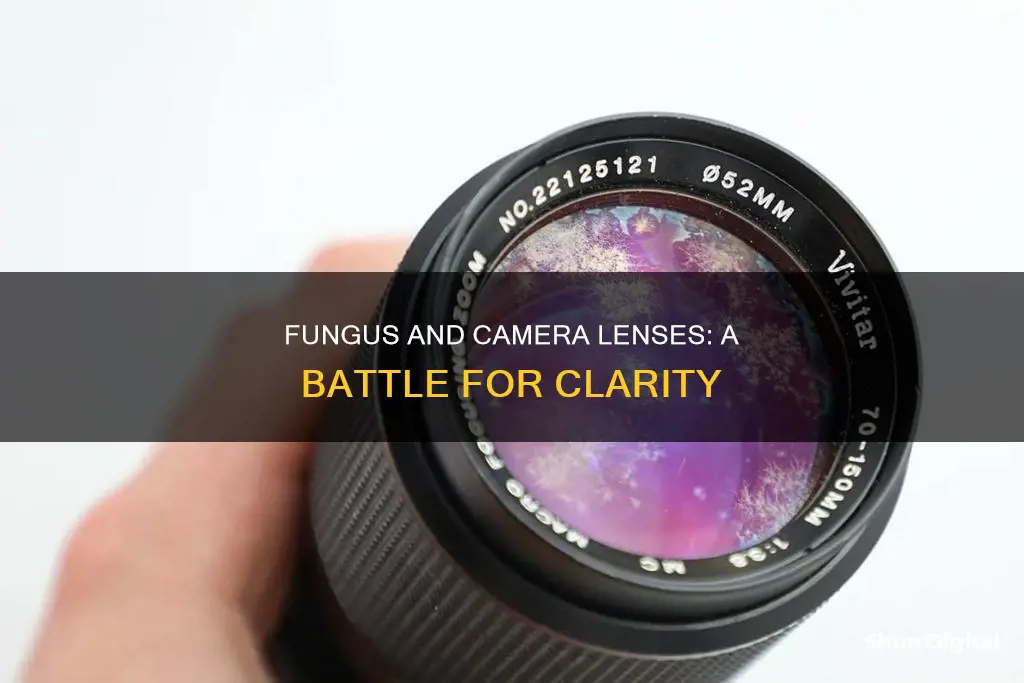
Camera lens fungus is a common issue for photographers, especially in humid climates. It occurs when dust containing fungal spores combines with moisture, resulting in the growth of fungus inside the lens. This can lead to fuzzy or hazy images and, if left untreated, can permanently damage the lens.
Fungal spores are microscopic and can be found almost everywhere, including in the air and on surfaces. When a lens is focused, it pulls in air, providing an entry point for these spores. The spores remain inert until they find suitable growing conditions, typically in dark and damp environments.
To prevent lens fungus, it is crucial to store lenses properly. This includes keeping them in cool, dry places, preferably in see-through or humidity-controlled cabinets with silica gel packets. Additionally, regular cleaning and wiping down of lenses after use can help inhibit the growth of fungus.
| Characteristics | Values |
|---|---|
| What is it? | Fungus is one of the earliest known life forms on the planet. |
| How does it get there? | Microscopic spores carried in the air. |
| How does it grow? | Fungus grows in dark and damp conditions. |
| What does it look like? | Small web-like spots or patches, strands or blooms. |
| What does it feed on? | Fungus does not feed on the glass itself but on materials used in the manufacture of the optics and/or that adhere to it (leather, paint, wood, putty, adhesives, fibres). |
| How to prevent it? | Keep lenses in cool, dry places with good ventilation and low humidity. |
| How to treat it? | Affected lenses should be evaluated by a professional lens technician to determine if they can be cleaned. |
What You'll Learn

Fungus thrives in dark, moist environments
Lens fungus is more likely to occur in lenses that are not weather-sealed and are used in humid, tropical climates. It can manifest as small web-like spots or patches inside the lens, eventually leading to a complete "blindness" of the optics if left untreated. The fungus feeds on materials used in the manufacture of the optics or substances that adhere to it, such as fingerprints, vapours from plastics, or grease. It can also attack lens surfaces if organic material has deposited on them.
To prevent the growth of lens fungus, it is crucial to store lenses properly. Since fungus thrives in dark and moist areas, storing lenses in a see-through or humidity-controlled cabinet with silica gel packets can help inhibit its growth. Silica gel absorbs moisture, while the see-through container allows light to enter, which can kill the fungus. Additionally, keeping lenses in cool, dry places and maintaining proper ventilation can also deter the growth of fungus.
For lenses that are frequently used, it is recommended to wipe them down with a lint-free cloth after each use, especially in humid or wet conditions. Placing the lenses in front of a fan after wiping them down can further help evaporate any remaining moisture.
Unlocking the Secrets of Commercial Camera Lenses' Diffraction Limits
You may want to see also

It's a combination of dust and moisture
Lens fungus is a combination of dust and moisture that finds its way into the interior elements of a camera lens. Dust does not typically cause a problem, but if that dust contains fungus spores and combines with moisture, then fungus can grow.
Fungus thrives in dark, humid, and moist environments, which is why it is more common in lenses that are not weather-sealed and are used in very humid, tropical areas. It is important to note that lens fungus is not specific to a particular type of fungus, but rather a general term for the infestation of optical devices by fungal threads.
To prevent lens fungus from growing, it is recommended to monitor the moisture and temperature status of the environment and keep lenses in cool, dry places. Storing lenses properly in a see-through or humidity-controlled cabinet with silica gel packets can help inhibit the growth of fungus. Additionally, keeping the surfaces of the front and rear lenses free from dust, fibres, and other organic materials can help prevent the fungus from finding a food source.
If lens fungus is suspected, it is best to have the lens evaluated by a professional technician to determine if it can be cleaned. While some sources suggest using UV light or other methods to kill the fungus, it is important to exercise caution as these methods may not be effective or may damage the lens.
Analog Camera Lenses: Interchangeable or Not?
You may want to see also

It can permanently damage lenses
Fungus can permanently damage camera lenses. If left untreated, it can cause irreversible damage to the lens's performance, resulting in fuzzy or hazy images. The fungus grows on the lens, creating small web-like spots or patches that impair image quality. It can also lead to a significant loss in contrast and increased lens flare when shooting into the light.
The fungus physically damages the lens by attacking its coatings and, in some cases, etching the glass itself. This degradation of the lens surface results in permanent damage that cannot be reversed, even with professional cleaning. The longer the fungus is left untreated, the more severe the damage can become.
Additionally, the metabolic products produced by the fungus during its growth can also cause irreparable harm to the glass surfaces. These by-products are often acidic and can corrode the lens, further reducing its optical performance.
To prevent permanent damage, it is crucial to address lens fungus as soon as it is detected. Proper storage conditions, such as dry and cool environments, can help inhibit fungal growth. Regular cleaning and maintenance of lenses are also essential to mitigate the risk of permanent damage.
While some sources suggest home remedies for removing lens fungus, it is generally recommended to seek professional assistance. Attempting to clean the fungus without proper knowledge and tools may lead to further damage to the lens.
Choosing the Right Camera Lenses for Red Carpet Events
You may want to see also

It's not covered under warranty
Unfortunately, lens fungus is not covered under warranty. However, there are steps you can take to prevent and treat lens fungus.
Lens fungus is a combination of dust and moisture that finds its way into the interior elements of a camera lens. It is more common with lenses that are not weather-sealed and used in very humid, tropical areas. It can look like small web-like spots or patches inside the lens. If left untreated, the fungus can permanently decrease the lens's performance and cause your images to look fuzzy or hazy.
To check for lens fungus, remove the lens from the camera and the front and rear lens caps. Ensure you have plenty of light, then look through both ends of the lens to spot any fungus growth. If you suspect lens fungus, a professional lens technician should evaluate the lens to determine if it can be cleaned.
To prevent lens fungus, monitor the moisture and temperature status of your environment and keep your lenses in cool, dry places. Store your lenses in a see-through or humidity-controlled cabinet with silica gel packets, especially if you are not going to use them for a long time. The silica gel packets absorb moisture, while the see-through container allows light inside to inhibit fungus growth. Check the silica gel packets periodically and discard them if they have absorbed water.
If you discover lens fungus, it may be possible to clean the lens. However, this can be challenging, as it often involves disassembling the lens to reach the affected elements. In some cases, the fungus may have etched the surface of the lens elements, resulting in irreparable damage. Therefore, it is recommended to consult a professional lens technician or the manufacturer for cleaning advice.
Drying Camera Lenses: Quick and Easy Steps for Photographers
You may want to see also

Proper storage can prevent fungal growth
Lens fungus is a common issue for camera owners, especially in humid climates. It occurs when dust containing fungal spores combines with moisture and finds its way into the interior elements of a camera lens. If left untreated, it can permanently damage the lens, decreasing its performance and causing images to look fuzzy or hazy. Therefore, proper storage is crucial to prevent fungal growth and maintain the longevity of your camera equipment.
- Keep your lenses in a cool, dry place: Fungus thrives in dark, moist, and warm environments, so storing your lenses in a cool, dry location will help inhibit its growth.
- Monitor the moisture and temperature: Regularly check the moisture and temperature levels in your storage area to ensure they are within optimal ranges.
- Use silica gel packets: Silica gel absorbs moisture and can be placed in storage containers to help keep your lenses dry. Remember to replace the silica gel packets periodically when they become saturated with water.
- Store in a see-through container: Transparent containers allow light to enter, which can help inhibit fungal growth. Additionally, using a humidity-controlled cabinet can help maintain optimal relative humidity levels.
- Keep lenses in an airtight box: An airtight box or bag can help prevent moisture from reaching your lenses. This is especially important if you live in a humid region.
- Use a dehumidifier or air conditioner: These appliances help regulate the humidity and temperature in your storage area, creating an unfavourable environment for fungal growth.
- Keep lenses away from direct sunlight: While light can inhibit fungal growth, direct sunlight can cause damage to your camera's image sensor.
- Regular cleaning: Wipe down your lenses regularly with a microfiber cloth, especially after using them in hot and humid conditions. This will remove any dust, fibres, or organic material that could serve as food for fungus.
By following these storage and maintenance tips, you can effectively prevent lens fungus and protect your camera equipment. Proper care will not only maintain the performance of your lenses but also preserve their value over time.
Dual-Lens Camera Tech: How Does It Work?
You may want to see also
Frequently asked questions
Fungus grows in camera lenses when dust containing fungus spores combines with moisture. This is more likely to occur in lenses that are not weather-sealed and in humid environments.
Fungus in a camera lens can look like small web-like spots or patches inside the lens, ranging from small, barely visible points to an irregularly spreading mesh.
If left untreated, fungus can permanently damage the lens, decreasing its performance and causing images to look fuzzy or hazy.
To prevent fungus from growing in your camera lens, keep your lenses in a cool, dry place, out of dark and moist areas where fungus thrives. You can also store your lenses with silica gel packets, which absorb moisture, and in see-through containers, which allow light inside that can kill fungus. Additionally, keep your lenses clean and free from dust, fibres, and other organic material that can provide nutrition for fungus.







